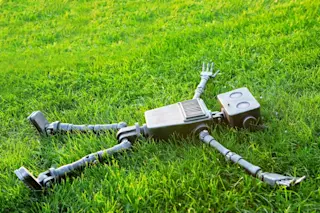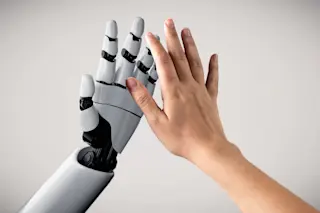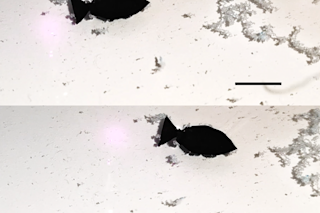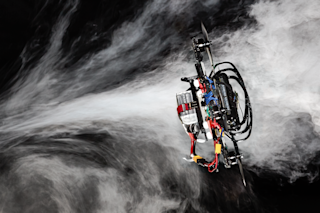To create a new material, re-searchers often start with a known one, knock out an atom or two, and see what luck brings. Because the number of possible combinations of elements is vast, such operations can take an entire day in the lab.
To quicken the pace of discovery, physicist Xiao-Dong Xiang and chemist Peter Schultz at Lawrence Berkeley National Laboratory developed a technique for making and testing up to 10,000 new combinations at the same time. Xiang and Schultz take a one-inch-square grid and spray on it layer upon layer of different substances in a variety of concentrations. The trick, of course, is to get each substance to land precisely on predetermined points on the grid. To accomplish this, they use stencil-like masks similar to the ones engineers use to imprint electronic circuits on microchips. At each point on the grid, different combinations of substances overlap and react with one another, forming a microscopic experiment. Once the reactions have taken place, Xiang and Schultz test each of the points on the grid for superconductivity and other desired properties.
The advantage of this approach, called combinatorial synthesis, is that scientists can use the tried-and-true method of trial and error but use it more efficiently. We’re trying to accelerate this trial-and-error feedback process, just as a computer does, Xiang explains. We’re not changing the way we use our intelligence to guide our search or do the science. We are developing a powerful technology that will speed the process.
Xiang published his first proof-of-concept paper last June. Now he is trying to increase the size of his grid so he can test 40,000 combinations at once.
Finalists
Radar for Everyone
Lawrence Livermore’s
Micropower Impulse Radar
Innovator: Thomas McEwan
While trying to develop a radar that could detect Stealth bombers, Thomas McEwan had a brainstorm. I was fascinated by how the system was detecting me walking around the room, he recalls, and while I was looking at the computer display--this was back in 1992--it suddenly struck me that there was a way I could make it a hundred times cheaper and turn the system into a really nice burglar alarm.
McEwan, an electronics engineer at Lawrence Livermore National Laboratory in California, soon invented what he calls Micropower Impulse Radar, an affordable home radar for detecting things and people that go bump in the night. Conventional long-range radar works by sending a powerful pulse of radio waves outward and timing how long it takes for the echo to return. To make a burglar alarm, however, a radar has to concern itself with objects only a certain fixed, short distance away--the perimeter of your house. If the radar hears an unexpected echo from within that perimeter, it knows an intruder has entered.
Because the radar needed to operate only at these fixed, short distances, McEwan was able to simplify its electronics to such an extent that it can operate on low-power batteries--its pulses are about a million times weaker than the signals of a cellular phone. The device is only about the size of a credit card and costs less than $10 to manufacture. Last year Livermore began licensing the low-power radar to commercial firms. So far, 15 of them have signed on, and they are using the technology not just in burglar alarms but in automobile bumpers that warn of impending collisions, an electronic dipstick that measures fluid levels in underground storage tanks, and tools that can locate metal in concrete.
Army of Workers
MIT’s Robotic Ants
Innovator: James McLurkin
Robots need not be big to be useful. Imagine keeping a little colony of robots nestled under your refrigerator: when you turn off the lights at night, they scurry out to pick crumbs off your floor; they might even defend your cupboard against roaches and other pests.
James McLurkin, a 24-year-old researcher at mit’s Artificial Intelligence Laboratory, has built a small army of 12 robots that may be the forerunners of such useful critters. Each one is about the size of a large walnut, weighs just over an ounce, and carries four light sensors, four infrared receivers, bump sensors, tilt sensors, and sensors for detecting the presence of food--all on its tiny frame.
McLurkin took his inspiration from real ants, collectively complex even though each is simple. To keep the cost down to $300 each, he stuck with commercially available parts, canvassing hundreds of distributors to find the smallest available. He and colleagues built the gearboxes, mandibles, and other ant parts, wiring and soldering them by hand. Five circuit boards fastened together form the insect robot’s outer shell--a kind of exoskeleton--which is transported on tiny tanklike treads.
McLurkin’s robots have modest microprocessor chips but exhibit nothing resembling artificial intelligence. They’re always bumping into one another. But they at least have enough intelligence to communicate with one another via infrared signals and to play a spirited game of tag or follow the leader. Last June, McLurkin began encouraging his ants to practice cooperative foraging and navigating to and from a nest. He believes larger versions of these robots will eventually be useful in searching for bombs or sorting garbage for recycling. You’d set the robots loose, he says, and return several months later to find the landfill arranged into the four piles you requested, and a whole lot of bored robots waiting around for something else to do.
The Incredible Shrinking Lab
Oak Ridge’s Lab on a Chip
Innovator: J. Michael Ramsey
If you’ve ever gone for a blood test, you might have wondered why the nurse needed to fill so many vials. It’s because the machines that medical labs use to automate blood tests cannot handle small quantities with enough accuracy--they need several milliliters of blood at a minimum to get the results right. The need to draw so much blood creates disposal problems for hospitals and makes it hard to develop a home blood-testing kit. Yet there’s no reason, in principle, that the same tests cannot be performed with minute quantities of blood.
J. Michael Ramsey at Oak Ridge National Laboratory in Tennessee looked to the technology of computer chips for a way to handle these small quantities. Engineers, after all, have for decades been perfecting techniques for making integrated circuits, or chips, with the tiniest of wires. Rather than making tiny wires to carry electricity, Ramsey thought, why not instead make channels for carrying blood and other liquids? Ramsey, whose work is sponsored by Lockheed Martin Energy Research Corporation, invented an electronic valve that can be built into a microchip. Ramsey’s valves, which have no moving parts, take advantage of molecules in the blood that carry an electric charge. By creating a voltage in a channel, the valves can force these charged molecules to move through the channel in one direction or another, dragging the rest of the blood along with them.
To use his lab on a chip, Ramsey places blood or another liquid in reservoirs carved into its surface. By typing commands into a computer, he can open and close the valves in such a way as to carry out the prescribed steps of a test. The liquids run through the microfabricated channels and combine in the microfabricated equivalents of beakers and test tubes.
Ramsey’s lab on a chip is about as big as a dime, and it can do a blood test using less than a billionth of a liter of blood--too little to see without a magnifying glass. Oak Ridge recently licensed the technology to Caliper Technology of Palo Alto, California, and Molecular Tool of Baltimore. Now that Ramsey has successfully used the technique for room- temperature reactions, he plans to test his device with reactions that require heat. What you could do, essentially, is put a little metal film on it and heat it up resistively, like a stove top, he says.
Eavesdropping on the Brain
University of Michigan’s
Micro Brain Probes
Innovator: Kensall Wise
Kensall Wise first became interested in creating tiny electronic devices for stimulating and monitoring the activity of nerve cells when he was a Ph.D. student in electrical engineering, and he’s been at it ever since. I suspect I’m the only person on the planet who is still working on his thesis after 30 years, he jokes.
His diligence has paid off. Wise, now a professor at the University of Michigan in Ann Arbor, has perfected an electronic probe that can be implanted deep into brain tissue and used to monitor and stimulate the brain. His devices are sword-shaped integrated circuits thinner than a human hair and sensitive enough to detect the minute electrical impulses that pass between nerve cells. Last year he arranged his probes into an array that looks a little like the sole of a tiny track shoe. Wise inserted the array into the brain of a guinea pig and used it to monitor a three- dimensional patch of brain tissue--something nobody had ever done before.
The device opens the door to more sophisticated brain experiments and prosthetic devices. For instance, two groups of researchers are now studying how to use the probe array developed by Wise as the basis of an artificial eye. So far, Wise has used his device only on animals, but he hopes to begin testing it soon on humans. I think within the next few years, the first applications of the technology in things that will really help people will be occurring, Wise says. To me that will be very satisfying.














